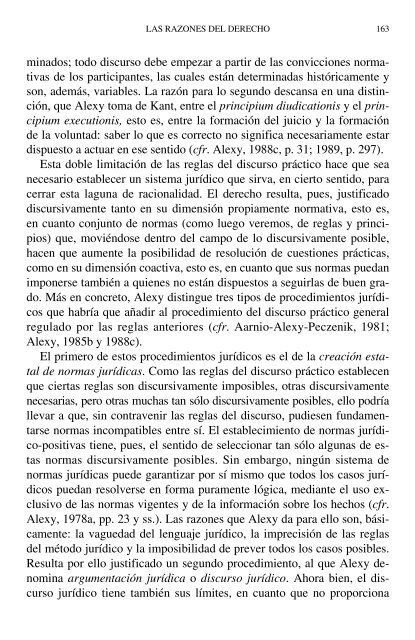LAS RAZONES DEL DERECHO Teo rías de la ar gu men ta ción ju rí di ca
You also want an ePaper? Increase the reach of your titles
YUMPU automatically turns print PDFs into web optimized ePapers that Google loves.
<strong>LAS</strong> <strong>RAZONES</strong> <strong>DEL</strong> <strong>DERECHO</strong> 163<br />
minados; todo <strong>di</strong>scurso <strong>de</strong>be empez<strong>ar</strong> a p<strong>ar</strong>tir <strong>de</strong> <strong>la</strong>s convicciones normativas<br />
<strong>de</strong> los p<strong>ar</strong>ticipantes, <strong>la</strong>s cuales están <strong>de</strong>terminadas históri<strong>ca</strong><strong>men</strong>te y<br />
son, a<strong>de</strong>más, v<strong>ar</strong>iables. La razón p<strong>ar</strong>a lo se<strong>gu</strong>ndo <strong>de</strong>s<strong>ca</strong>nsa en una <strong>di</strong>stin<strong>ción</strong>,<br />
que Alexy toma <strong>de</strong> Kant, entre el principium <strong>di</strong>u<strong>di</strong><strong>ca</strong>tionis y el principium<br />
executionis, esto es, entre <strong>la</strong> forma<strong>ción</strong> <strong>de</strong>l <strong>ju</strong>icio y <strong>la</strong> forma<strong>ción</strong><br />
<strong>de</strong> <strong>la</strong> volun<strong>ta</strong>d: saber lo que es correcto no signifi<strong>ca</strong> neces<strong>ar</strong>ia<strong>men</strong>te est<strong>ar</strong><br />
<strong>di</strong>spuesto a actu<strong>ar</strong> en ese sentido (cfr. Alexy, 1988c, p. 31; 1989, p. 297).<br />
Es<strong>ta</strong> doble limi<strong>ta</strong><strong>ción</strong> <strong>de</strong> <strong>la</strong>s reg<strong>la</strong>s <strong>de</strong>l <strong>di</strong>scurso práctico hace que sea<br />
neces<strong>ar</strong>io es<strong>ta</strong>blecer un sistema <strong>ju</strong><strong>rí</strong><strong>di</strong>co que sirva, en cierto sentido, p<strong>ar</strong>a<br />
cerr<strong>ar</strong> es<strong>ta</strong> <strong>la</strong><strong>gu</strong>na <strong>de</strong> racionalidad. El <strong>de</strong>recho resul<strong>ta</strong>, pues, <strong>ju</strong>stifi<strong>ca</strong>do<br />
<strong>di</strong>scursiva<strong>men</strong>te <strong>ta</strong>nto en su <strong>di</strong><strong>men</strong>sión propia<strong>men</strong>te normativa, esto es,<br />
en cuanto con<strong>ju</strong>nto <strong>de</strong> normas (como luego veremos, <strong>de</strong> reg<strong>la</strong>s y principios)<br />
que, moviéndose <strong>de</strong>ntro <strong>de</strong>l <strong>ca</strong>mpo <strong>de</strong> lo <strong>di</strong>scursiva<strong>men</strong>te posible,<br />
hacen que au<strong>men</strong>te <strong>la</strong> posibilidad <strong>de</strong> resolu<strong>ción</strong> <strong>de</strong> cuestiones prácti<strong>ca</strong>s,<br />
como en su <strong>di</strong><strong>men</strong>sión coactiva, esto es, en cuanto que sus normas puedan<br />
imponerse <strong>ta</strong>mbién a quienes no están <strong>di</strong>spuestos a se<strong>gu</strong>ir<strong>la</strong>s <strong>de</strong> buen grado.<br />
Más en concreto, Alexy <strong>di</strong>stin<strong>gu</strong>e tres tipos <strong>de</strong> proce<strong>di</strong>mientos <strong>ju</strong><strong>rí</strong><strong>di</strong>cos<br />
que hab<strong>rí</strong>a que aña<strong>di</strong>r al proce<strong>di</strong>miento <strong>de</strong>l <strong>di</strong>scurso práctico general<br />
re<strong>gu</strong><strong>la</strong>do por <strong>la</strong>s reg<strong>la</strong>s anteriores (cfr. A<strong>ar</strong>nio-Alexy-Peczenik, 1981;<br />
Alexy, 1985b y 1988c).<br />
El primero <strong>de</strong> estos proce<strong>di</strong>mientos <strong>ju</strong><strong>rí</strong><strong>di</strong>cos es el <strong>de</strong> <strong>la</strong> crea<strong>ción</strong> es<strong>ta</strong><strong>ta</strong>l<br />
<strong>de</strong> normas <strong>ju</strong><strong>rí</strong><strong>di</strong><strong>ca</strong>s. Como <strong>la</strong>s reg<strong>la</strong>s <strong>de</strong>l <strong>di</strong>scurso práctico es<strong>ta</strong>blecen<br />
que cier<strong>ta</strong>s reg<strong>la</strong>s son <strong>di</strong>scursiva<strong>men</strong>te imposibles, otras <strong>di</strong>scursiva<strong>men</strong>te<br />
neces<strong>ar</strong>ias, pero otras muchas <strong>ta</strong>n sólo <strong>di</strong>scursiva<strong>men</strong>te posibles, ello pod<strong>rí</strong>a<br />
llev<strong>ar</strong> a que, sin contravenir <strong>la</strong>s reg<strong>la</strong>s <strong>de</strong>l <strong>di</strong>scurso, pu<strong>di</strong>esen funda<strong>men</strong>t<strong>ar</strong>se<br />
normas incompatibles entre sí. El es<strong>ta</strong>blecimiento <strong>de</strong> normas <strong>ju</strong><strong>rí</strong><strong>di</strong>co-positivas<br />
tiene, pues, el sentido <strong>de</strong> seleccion<strong>ar</strong> <strong>ta</strong>n sólo al<strong>gu</strong>nas <strong>de</strong> es<strong>ta</strong>s<br />
normas <strong>di</strong>scursiva<strong>men</strong>te posibles. Sin emb<strong>ar</strong>go, ningún sistema <strong>de</strong><br />
normas <strong>ju</strong><strong>rí</strong><strong>di</strong><strong>ca</strong>s pue<strong>de</strong> g<strong>ar</strong>antiz<strong>ar</strong> por sí mismo que todos los <strong>ca</strong>sos <strong>ju</strong><strong>rí</strong><strong>di</strong>cos<br />
puedan resolverse en forma pura<strong>men</strong>te lógi<strong>ca</strong>, me<strong>di</strong>ante el uso exclusivo<br />
<strong>de</strong> <strong>la</strong>s normas vigentes y <strong>de</strong> <strong>la</strong> informa<strong>ción</strong> sobre los hechos (cfr.<br />
Alexy, 1978a, pp. 23 y ss.). Las razones que Alexy da p<strong>ar</strong>a ello son, bási<strong>ca</strong><strong>men</strong>te:<br />
<strong>la</strong> va<strong>gu</strong>edad <strong>de</strong>l len<strong>gu</strong>aje <strong>ju</strong><strong>rí</strong><strong>di</strong>co, <strong>la</strong> imprecisión <strong>de</strong> <strong>la</strong>s reg<strong>la</strong>s<br />
<strong>de</strong>l método <strong>ju</strong><strong>rí</strong><strong>di</strong>co y <strong>la</strong> imposibilidad <strong>de</strong> prever todos los <strong>ca</strong>sos posibles.<br />
Resul<strong>ta</strong> por ello <strong>ju</strong>stifi<strong>ca</strong>do un se<strong>gu</strong>ndo proce<strong>di</strong>miento, al que Alexy <strong>de</strong>nomina<br />
<strong>ar</strong><strong>gu</strong><strong>men</strong><strong>ta</strong><strong>ción</strong> <strong>ju</strong><strong>rí</strong><strong>di</strong><strong>ca</strong> o <strong>di</strong>scurso <strong>ju</strong><strong>rí</strong><strong>di</strong>co. Ahora bien, el <strong>di</strong>scurso<br />
<strong>ju</strong><strong>rí</strong><strong>di</strong>co tiene <strong>ta</strong>mbién sus límites, en cuanto que no proporciona



